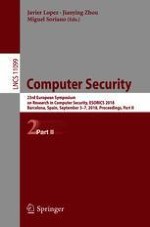2018 | Buch
Computer Security
23rd European Symposium on Research in Computer Security, ESORICS 2018, Barcelona, Spain, September 3-7, 2018, Proceedings, Part II
herausgegeben von: Prof. Javier Lopez, Jianying Zhou, Miguel Soriano
Verlag: Springer International Publishing
Buchreihe : Lecture Notes in Computer Science
